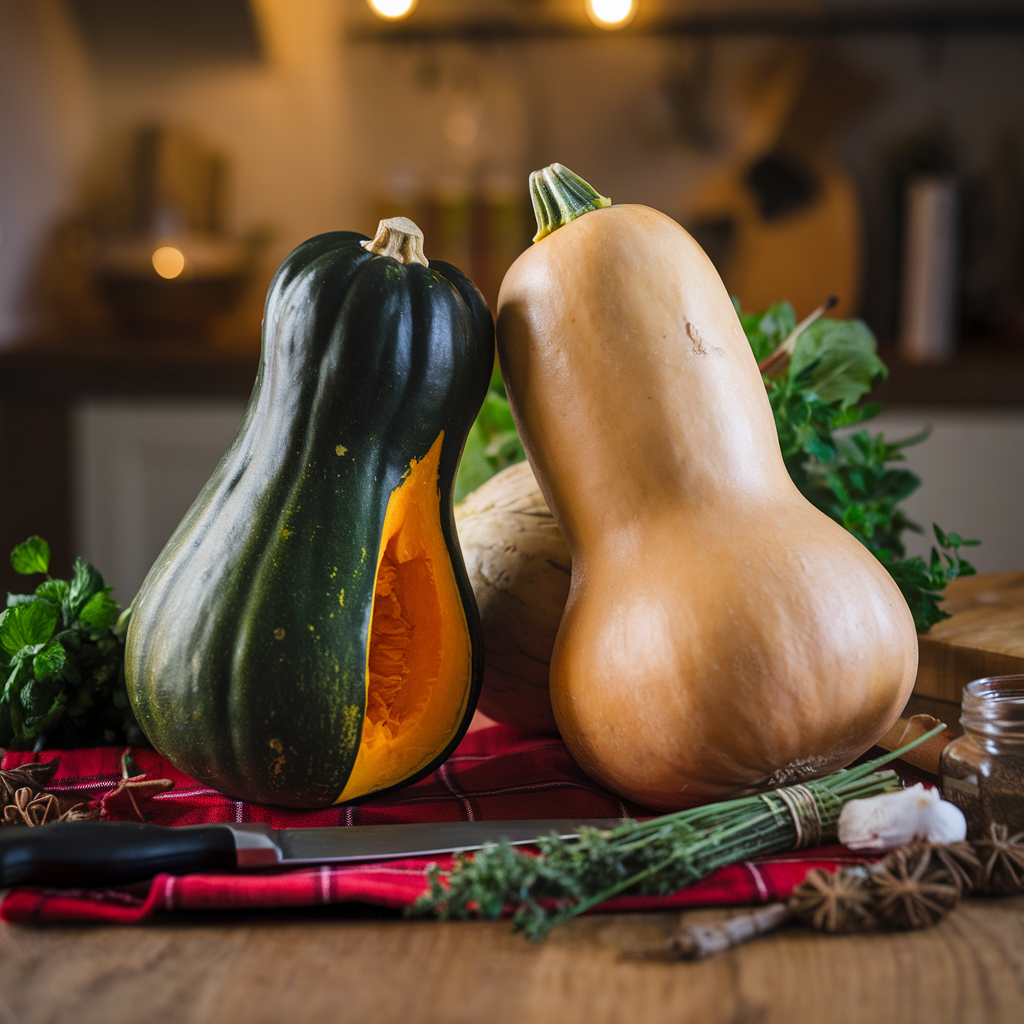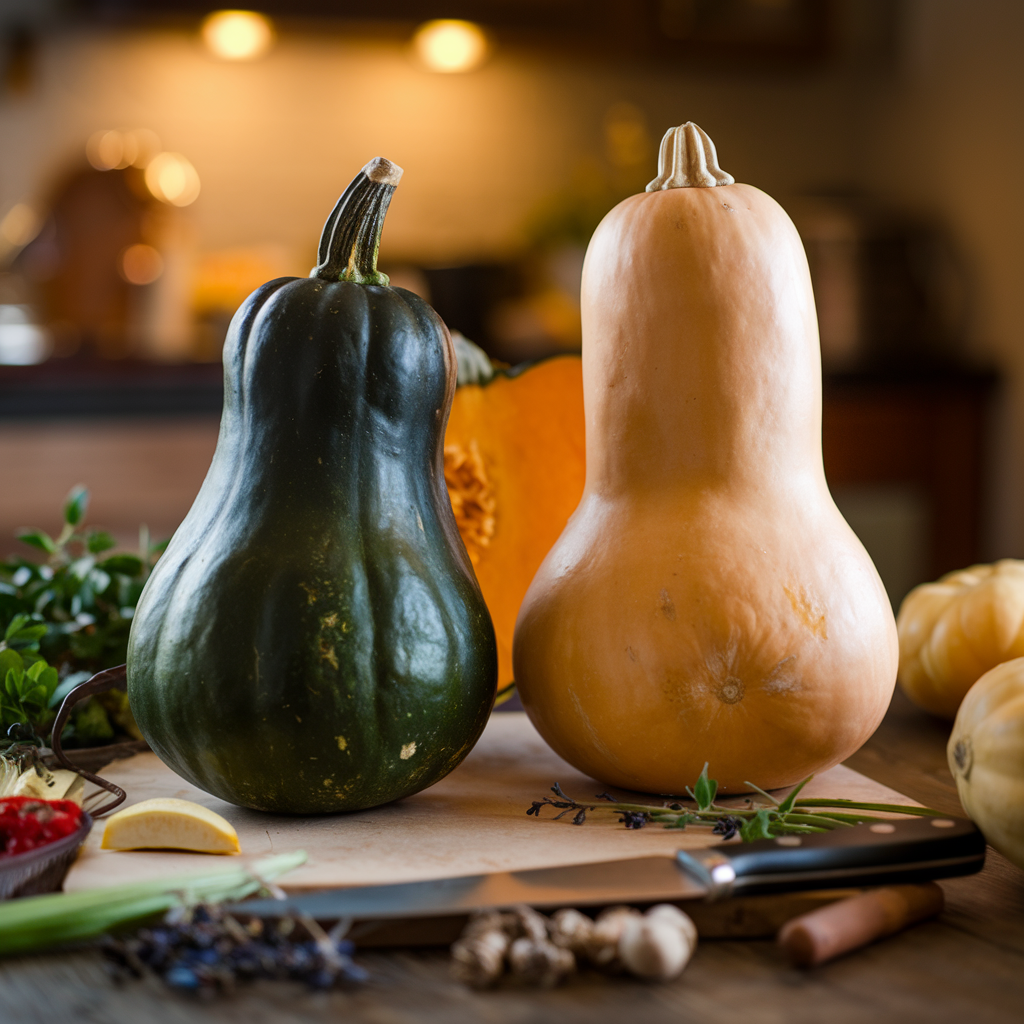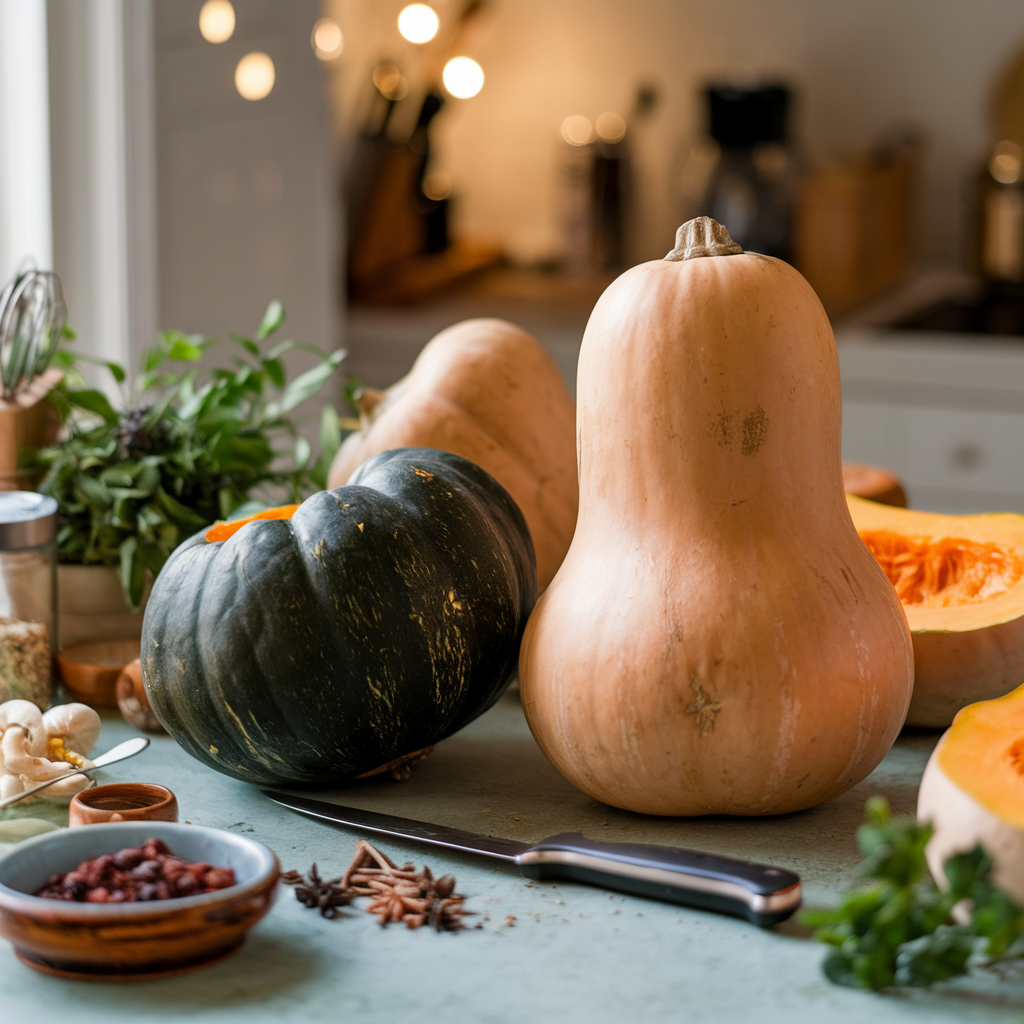Introduction
Squash is a versatile vegetable that comes in many varieties, each offering unique flavors, textures, and uses. Among the most popular types are kabocha squash and butternut squash. These two squashes are often compared because they share similarities, but they also have distinct differences that make each special. If you’ve ever wondered, are kabocha and butternut squash the same?, you’re in the right place.
In this article, we’ll explore the similarities and differences between kabocha and butternut squash in terms of taste, texture, nutritional value, culinary uses, and more. By the end, you’ll be able to tell these squashes apart and choose the right one for your cooking needs.
Key Points to Cover:
- Differences in taste and texture
- Nutritional comparisons
- Health benefits
- Culinary uses and recipes
- How to select and store both squashes

What is Kabocha Squash?
Kabocha squash, often called “Japanese pumpkin,” is a type of winter squash that originates from Japan. It’s known for its rich, sweet flavor and its dense, creamy texture. The skin is dark green, sometimes with a hint of gray, and the flesh is bright orange, similar to a pumpkin. Kabocha squash is a favorite ingredient in many Asian cuisines, especially Japanese, and it is also gaining popularity in other parts of the world due to its delicious taste and versatility.
Characteristics of Kabocha Squash
- Shape and Size: Typically round with a squat appearance, kabocha squash is smaller than many other winter squashes, with most varieties weighing between 2 and 5 pounds.
- Skin: The skin is thick but edible when cooked, making it a unique feature among winter squashes.
- Flavor: Kabocha squash has a sweet, earthy flavor that is often described as a cross between pumpkin and sweet potato. It’s less fibrous than some other squashes, which contributes to its creamy texture when cooked.
What is Butternut Squash?
Butternut squash is another popular variety of winter squash that is beloved for its mild, sweet flavor and smooth texture. It has a characteristic bell shape with a long neck and bulbous base. The skin is pale tan, and the flesh is a vibrant orange color. Butternut squash is often used in soups, stews, and roasted dishes, and it’s a favorite in both savory and sweet recipes.
Characteristics of Butternut Squash
- Shape and Size: Butternut squash is more elongated with a cylindrical shape, typically measuring 8 to 12 inches in length. It generally weighs around 2 to 3 pounds.
- Skin: The skin is thin, smooth, and pale tan, and although it is technically edible, many people prefer to peel it off before cooking.
- Flavor: The flavor is mildly sweet, nutty, and creamy when cooked, and it tends to be less starchy than other types of squash.
Key Differences Between Kabocha and Butternut Squash
1. Taste and Texture
One of the primary differences between kabocha and butternut squash is their taste and texture.
- Kabocha Squash: The taste is rich, sweet, and earthy, with a slightly buttery texture when cooked. The flesh is dense and velvety, often compared to a sweet potato or pumpkin.
- Butternut Squash: Butternut squash has a milder sweetness and a slightly nutty flavor. Its texture is smooth and creamy when cooked, but it is typically less dense than kabocha squash.
In recipes where you need a dense, creamy consistency, such as in purees or soups, kabocha squash may be the better choice. Butternut squash is often used for a lighter, smoother texture.
2. Nutritional Comparison
Both kabocha and butternut squash are packed with essential vitamins, minerals, and antioxidants. They are low in calories, rich in fiber, and provide a good amount of vitamins A and C. However, there are some subtle differences in their nutritional profiles.
Kabocha Squash Nutrients (per 100g serving):
- Calories: 51
- Carbs: 12.3g
- Fiber: 1.3g
- Protein: 1g
- Vitamin A: 340% of the Daily Value (DV)
- Vitamin C: 30% of the DV
- Potassium: 230mg
Butternut Squash Nutrients (per 100g serving):
- Calories: 45
- Carbs: 11.7g
- Fiber: 2g
- Protein: 1g
- Vitamin A: 106% of the DV
- Vitamin C: 22% of the DV
- Potassium: 400mg
While both squashes are nutrient-dense, kabocha squash is higher in vitamin A, while butternut squash has more potassium and fiber. If you’re looking for a squash rich in beta-carotene, kabocha is the winner.

Health Benefits of Kabocha and Butternut Squash
Both kabocha and butternut squash offer numerous health benefits due to their high nutritional content. These benefits include:
1. Rich in Antioxidants
Both types of squash are rich in antioxidants like vitamin A, which helps fight oxidative stress in the body. These antioxidants contribute to healthy skin, improved vision, and reduced inflammation.
2. Supports Digestion
The high fiber content of both squashes promotes healthy digestion and can prevent constipation. Butternut squash, in particular, contains more fiber, which helps maintain gut health.
3. Supports Immune Health
Both kabocha and butternut squash are excellent sources of vitamin C, which plays a key role in immune function. Consuming these squashes regularly can help strengthen your immune system.
4. Heart Health
Both squashes contain potassium, which is important for heart health. Potassium helps regulate blood pressure, reducing the risk of hypertension and other cardiovascular diseases.
How to Cook with Kabocha and Butternut Squash
Now that we know the differences in taste, texture, and nutritional benefits, let’s explore how you can use both types of squash in your kitchen.
1. Roasting
Both kabocha and butternut squash are fantastic when roasted. Simply slice the squash, toss it in olive oil, salt, and pepper, and roast in the oven at 400°F (200°C) for 25-30 minutes until tender and slightly caramelized.
- Kabocha Squash: The skin of kabocha squash is thick and edible, so you can roast it with the skin on. Roasting it will enhance its natural sweetness and create a creamy interior.
- Butternut Squash: While the skin is edible, many people prefer to peel it before roasting. Roasting enhances its sweetness and gives it a soft, melt-in-your-mouth texture.
2. Soups and Purees
Both squashes make excellent ingredients for soups and purees. You can blend roasted or boiled squash with broth and seasonings to create a smooth, flavorful soup.
- Kabocha Squash Soup: Kabocha squash has a richer flavor and creamier texture, making it perfect for hearty soups.
- Butternut Squash Soup: Butternut squash has a more delicate flavor, making it ideal for lighter, more refined soups.
3. Baking
Both types of squash can be used in baking recipes like muffins, pies, or cakes. Kabocha squash’s dense texture makes it great for hearty baked goods, while butternut squash adds moisture and flavor to lighter pastries.
How to Choose and Store Kabocha and Butternut Squash
Choosing Kabocha Squash
When selecting a kabocha squash, look for one that is heavy for its size with a firm skin. Avoid any squashes with soft spots or blemishes. A good kabocha squash will have a deep green color, and the skin should be relatively smooth.
Choosing Butternut Squash
When choosing butternut squash, look for a squash with a smooth, firm skin. The color should be a rich, tan hue, and the squash should feel heavy for its size. Avoid any squashes with cuts or wrinkles, as these can affect the flavor and texture.
Storing Squash
Both kabocha and butternut squash should be stored in a cool, dry place, such as a pantry. They can be kept for up to 1-3 months when stored properly. Once cut, store the squash in the refrigerator and use it within 3-5 days.
FAQ: Everything You Need to Know About Kabocha and Butternut Squash
1. What is the main difference between kabocha and butternut squash?
The main difference between kabocha and butternut squash lies in their taste, texture, and appearance. Kabocha squash is typically round with dark green skin and has a sweet, rich flavor with a dense, creamy texture. Butternut squash, on the other hand, has a bell-shaped form with smooth tan skin and a milder, nutty sweetness with a smoother, lighter texture when cooked.
2. Is kabocha squash sweeter than butternut squash?
Yes, kabocha squash tends to be sweeter and richer in flavor compared to butternut squash. Its natural sweetness is often described as a mix between pumpkin and sweet potato, making it ideal for savory and sweet dishes. Butternut squash is also sweet but has a more delicate, nutty flavor.
3. Can you substitute kabocha squash for butternut squash in recipes?
Yes, you can substitute kabocha squash for butternut squash in many recipes, particularly in soups, stews, and baked dishes. However, keep in mind that kabocha squash is denser and sweeter than butternut squash, which might slightly alter the texture and flavor of your dish.
4. Which squash is healthier: kabocha or butternut squash?
Both kabocha and butternut squash are healthy choices, offering high fiber, vitamins, and antioxidants. Kabocha squash is higher in vitamin A, while butternut squash provides more potassium and fiber. Depending on your nutritional needs, either squash could be a great addition to your diet.
5. How do you cook kabocha squash?
Kabocha squash can be roasted, steamed, boiled, or pureed. It has a thick skin that is edible when cooked, so you can roast it with the skin on for added texture. You can also make kabocha squash soup, puree it for pies, or mash it as a side dish. The cooking method you choose will depend on the recipe and your preference for texture.
6. How do you cook butternut squash?
Butternut squash is commonly roasted, sautéed, or pureed. Unlike kabocha squash, the skin of butternut squash is often peeled before cooking due to its thinner texture. Roasting butternut squash enhances its natural sweetness and creamy texture, making it ideal for soups, casseroles, and salads.
7. Is kabocha squash easier to cook than butternut squash?
In terms of preparation, kabocha squash can be easier to cook than butternut squash because its skin is thick but edible. Many people prefer to leave the skin on when roasting or cooking kabocha squash, saving time on peeling. However, butternut squash often requires peeling before cooking, which can be more time-consuming.
8. Can you eat the skin of kabocha squash?
Yes, you can eat the skin of kabocha squash. The skin is thick but tender when cooked, making it an enjoyable part of the dish. Many people roast it with the skin on for extra flavor and texture. However, some people may choose to peel the skin if they prefer a smoother texture.
9. How should you store kabocha and butternut squash?
Both kabocha and butternut squash should be stored in a cool, dry place, such as a pantry or cellar. They can last for 1-3 months if stored properly. Once cut, store the squash in the refrigerator and use it within 3-5 days. For long-term storage, you can also freeze squash after cooking or pureeing it.
10. What are some easy recipes to try with kabocha squash?
Kabocha squash is versatile and can be used in a variety of dishes. Some easy and delicious recipes to try include:
- Roasted kabocha squash with olive oil and herbs
- Kabocha squash soup with coconut milk
- Kabocha squash curry
- Mashed kabocha squash as a side dish
- Kabocha squash pie or cake
Conclusion
So, are kabocha and butternut squash the same? While they share some similarities as winter squashes, they are distinct in taste, texture, and nutritional content. Kabocha squash has a richer, sweeter flavor and denser texture, while butternut squash is milder, smoother, and often easier to peel. Both squashes offer numerous health benefits and are versatile ingredients in a variety of dishes.
Now that you know the differences and benefits of both, you can confidently choose the right squash for your next meal. Whether you’re making soups, roasting them, or incorporating them into your favorite recipes, both kabocha and butternut squash are fantastic options for a nutritious and delicious meal.

